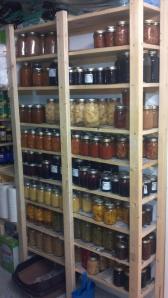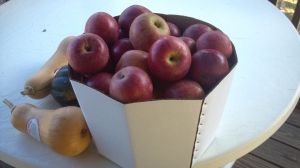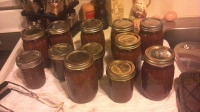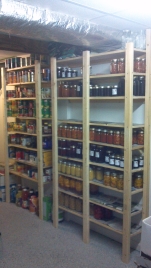HEIRLOOM CORN INFORMATION & WHERE YOU CAN BUY IT.
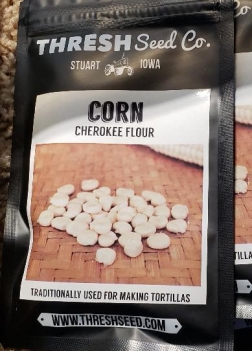 This is a long read. But, for those genuinely interested, I hope you will appreciate the effort to preserve the history and use of Heirloom corn. Today, there are 142 different types of genetically modified corn, the most of any plant species. Almost 90-05% of the corn grown in the United States goes into animal feed and biofuels, while the remainder is processed down into various ingredients such as high-fructose corn syrup and corn starch, or used as the source material to make ingredients such as alcohol and citric acid. Yuo can track the history of the adoption of GMO Corn, since 1996 with the following links to see just how pervasive GMO corn is today.
This is a long read. But, for those genuinely interested, I hope you will appreciate the effort to preserve the history and use of Heirloom corn. Today, there are 142 different types of genetically modified corn, the most of any plant species. Almost 90-05% of the corn grown in the United States goes into animal feed and biofuels, while the remainder is processed down into various ingredients such as high-fructose corn syrup and corn starch, or used as the source material to make ingredients such as alcohol and citric acid. Yuo can track the history of the adoption of GMO Corn, since 1996 with the following links to see just how pervasive GMO corn is today.
MORE ABOUT HEIRLOOM CORN
Notably, corn is our most studied, our most tinkered with vegitable, and, some would claim, our most debased of all New World vegetables. Its history is long and complex, and the literature of corn is immense. Corn most likely originated in southern Mexico near Oaxaca and was developed from the wild annual grass, teosinte. The name, of Nahuátl Indian origin, is interpreted to mean “grain of the gods.” Scientific evidence indicates that one particular form of teosinte, known as Zea mays ssp parviglumis, is the direct ancestor of maize.
Corn has been cultivated in the Americas for at least 5,000 years. Yep, 5,000 years! Although the process of domestication is thought to have started between seven and twelve thousand years ago. Betty Fussell’s fairly recent Story about Corn (1992) is a good introduction to how corn evolved from a Native American food of deeply sacred character into the sugar-enhanced Cola corns of today.
The late Sophie Goe’s America’s First Cuisines (1994) traces this story back to its roots in Mexico and Peru. The American industrialization of corn, the genetic revolution that has produced a whole new generation of corn varieties so unlike the robust corns of the past, has brought about fundamental changes in American agriculture that represent the very antithesis of what genetic diversity and seed saving is about.
The irony of it all is that corn, the ancient benefactor of the Indians, a living spiritual dimension of their culture and its symbiotic relationship with the land, has become one of the world’s cash crops. Because of this it is now inextricably enmeshed in political corruption and rapacious environmental destruction. There is no vegetable that closes the ranks among seed savers and proponents of sustainable agriculture more effectively than corn.
Unfortunately, corn is not an easy plant to preserve as an heirloom vegetable. It originated as a mutation and cannot survive in the wild. Therefore, its existence is wholly dependent on the intervention of man to ensure that it can pollinate and produce seed. The Indians were keenly aware of this and treated corn with a religious dedication found in no other cultures. Furthermore, their attitude toward corn was colored by a desire not to increase its productivity but to preserve its sacred character, for in their eyes it had human qualities.
The purity of seed color and of types of corn were paramount, for they had metaphysical meanings in Native American religion. For this reason, the Indian was also one of the most sophisticated savers of seed, able to accomplish through simple observation and without scientific training what whites must learn through years of university education. The American Indians were plant geneticists before the term was invented. Corn was life itself.
Native Americans appear to have categorized their corns by intended use: for flour, for hominy and porridge, for popping, and so forth. Each corn had its adjunct ceremonies and festive recipes. We inherited some of these corns from native peoples, and we have selectively borrowed some of their dialect names (such as flint) for types of corn, but we use them in much different ways.
The profundity of the changes that occurred as the cultivation of corn shifted from the Native American to the white man is acutely evident in Porter A. Browne’s Essay on Indian Corn (1837), which cataloged thirty-five of the most commonly raised varieties at the time. Very few were pure Indian sorts, and only a couple are still known today; the rest are probably extinct. Browne organized his corns by color. Among the yellows he listed King Philip Corn, which was still available, at the time this article was written. Under white corn, he mentioned Smith’s Early White and Mandan, in this case a sweet corn, and not the Mandan corn familiar to seed savers today. His list of red corns was the largest, including Guinea Corn, William Cobbett’s Corn, Dutton Flint, and a curious Mexican corn “found in a mummy.” Perhaps the Mexican corn released in the 1860s by Massachusetts seedsman James J. H. Gregory attempted by virtue of its provocative name to cash in on a similar implied ancient authenticity, like the Anastazi bean of today.
Horticulturists divide corn differently than did either the Indians, or the early corn specialists like Browne. All of the cultivated varieties belong to the same species and therefore readily cross with one another. In fact, corn is one of the easiest of all garden vegetables to cross, since it relies on windblown pollen for fertilization, and even the slightest puff of air can carry pollen a great distance. This promiscuity results in many varieties that fall between the five or six recognized types generally accepted by horticulturists. Of the garden varieties, these include popcorn (van praecox), dent corn (var. indentata), flint corn (var. indurate), soft corn, and sweet corn (van rugosa). If this discussion is shifted to Mexico, everything is turned topsy-turvy by the huge number of corns that evolved there. Their complicated pedigrees were analyzed in Paul Mangelsdorf’s Corn (1974), one of the breakthrough studies on the origins of this plant.
Popcorn is one of the oldest and hardiest of all the types and can be grown where many other corns do not thrive. It can be planted earlier in the spring than other varieties, but of course it will cross easily with any type of corn planted near it. Since popcorn pops best when the kernels are over a year old, this is a corn that must be allowed to ripen on the stalk, then properly dried indoors before storing in containers free of insects and moisture. Freezing it immediately before it is popped will increase the rate of popping. I have included two old varieties in my selection that not only pop beautifully but have a flavor not found in modern commercial varieties.
Dent corns are characterized by a dent or crease in the kernel, hence the Indian name “she-corn.” This type of corn is starchy and is generally used for roasting, corn bread, and hominy. It is a type best acclimated to the South and Southwest, where it seems to have developed the greatest number of varieties. Flint corns are the northern counterpart to this type. The kernels contain a high percentage of opaline, a mineral that gives the corn its gritty or “flinty” texture when ground. Flint corns are normally used for grits and hominy, as are many field corns.
Flour corns or soft corns are characterized by a kernel that is mostly starch when ripe, and therefore lends itself to grinding for flour. All North American Indians involved in agriculture maintained flour corns of one kind or another. Even though they are believed to have had a tropical origin, corns with this genetic feature were among the first to be dispersed by the Indians to all parts of our continent. The Tuscarora corn on my list is one of the classic Eastern corns of this type.
The Indians of North America distinguished between two types of sweet corn, the “green” or unripe corn of most corn types when they are in the so-called “milky” stage, and a corn with heavily wrinkled kernels that is naturally sweet by genotype. The sweet corn of white culture is this latter type. Historically, true sweet corn was a latecomer, reaching what is now the United States in the 1300s. It originated in Peru, where it is still used to make chicha, a fermented drink made in pre-Columbian times. Sweet corn derives its sweetness from a recessive gene, a mutation that has made it defective in converting sugar to starch. This characteristic was utilized by Native Americans for storing slow-ripening late-season varieties as “fresh” corn during part of the winter or for caramelizing the corn while in the husk over hot coals. This slow drying process resulted in a sweet-tasting dry corn that could be eaten as a snack or used in stews and vegetable mixtures.
According to anthropologist Helen Rountree (1990, 52), the Powhatans of Virginia made a corn-and-bean dish called pausarowmena that served as a staple dish during the winter. In the late summer, “green” corn or a variety of sweet corn was harvested and roasted in the husk over hot coals until dry and slightly caramelized, very much in taste and texture like the present-day dry sweet corn of the Pennsylvania Dutch. This dry sweet corn was stored in middens and reconstituted as needed with water. It was stewed with two types of beans, a large pole variety and a small bush bean. This combination of dried sweet corn and two distinct types of beans constituted the real “succotash” of the Powhatans and related peoples in the Middle Atlantic region.
Planting Corn
All open-pollinated corn must be planted differently from hybrids. For best results, plant the seed in blocks or squares 5 to 6 rows wide. John Brown, a farmer who lived on Lake Winnepesaukee in New Hampshire and who developed the variety known as King Philip Corn, noted in The Report of the Commissioner of Patents (1856, 175–76) that farmers in his region were still planting corn “the old way” in rows 4 feet apart in hills 3 feet from one another, four to six plants per hill. This method works well for heirloom varieties and will ensure good pollination with room between the hills for squash. Pole beans may be planted among the clumps of corn and allowed to climb up the stalks.
Among the Indians in the East, corn seed was generally treated in an herbal tea before it was planted. F. W. Waugh described some of these decoctions in Iroquois Foods and Food Preparation (1916, 18–20). After soaking in the tea, the corn was left wet in a basket so that it would sprout a little before planting. This treatment was thought to protect the corn, and may in fact have produced an odor to camouflage it from birds and insects. It had the additional benefit of separating viable seed from weak ones and avoiding seed that might otherwise rot in the ground.
Corn Seed Saving
For seed-saving purposes, there must be 200 seed-producing ears in the garden. Ripe, dry seed corn is taken from 25 to 50 of the very best ears and mixed together to ensure genetic diversity. Kernels must be hand-sorted for color and all of the best characteristics of the variety. Because it is a mutant, corn propagated from a small gene pool will undergo inbreeding depression quickly and irreversibly, just as humans do when they breed with close kin. This is the reason for the numbers given above. Geneticists have determined that they represent the critical mass in the gene pool for continued diversity and the healthy survival of the corn variety. There is no way to get around this; saving seed for corn requires space because 200 ears of corn translates into at least 100 plants arranged in 25 hills if planted the old way. Furthermore, seed corn must be allowed to ripen on the plants, then allowed to dry thoroughly before being sorted for storage. Sweet corns will remain viable for three years; the others five to ten years, sometimes longer. Animals can be a serious threat to a seed-saving program, so it is always advisable to overplant with a certain margin of loss in mind. However, the gardener need not be helpless before the ravages of raccoons, nature’s most expert corn thieves.
Warding Off Unwanted Pests
Ears of corn can be protected from raccoons and squirrels by wrapping the ears with 3/4-inch-wide packing tape, the sort with reinforced webbing of fiberglass or plastic. Circle the ear with the tape above where it is attached to the stalk, then gird the ear about 2 inches below the tip. Allow 24 inches of tape per ear, but do not wrap the tape so tightly that the corn cannot expand properly in the husk. The tape will keep the animals from pulling the ears off the stalks, and since the tape is reinforced, raccoons and squirrels cannot properly chew through it. It also foils crows.
If crows prove to be a special nuisance, the Farmer’s Almanac for 1864 had this effective advice: “Soak a few quarts of dried corn in whiskey, and scatter it over the fields for the crows. After partaking one such meal and getting pretty thoroughly corned, they will never return to it again.” I would use the brand of corn whiskey called Rebel Yell. It seems to fit the remedy and evoke some of the sounds I now associate with the birds at the height of their raucous inebriation. Incidentally, it works.
From Mother EarthNews, July 18, 2013
Written by William Woys Weaver. Heirloom Vegetable Gardening by William Woys Weaver is the culmination of some thirty years of first-hand knowledge of growing, tasting and cooking with heirloom vegetables. A staunch supporter of organic gardening techniques, Will Weaver has grown every one of the featured 280 varieties of vegetables, and he walks the novice gardener through the basics of planting, growing and seed saving. The following excerpt on heirloom corn varieties was taken from chapter 14, “Corn.”
‘Puhwem’ (‘Oklahoma Delaware White’) Corn, Zea mays 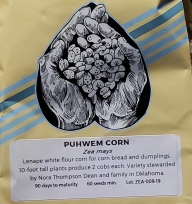
This fine old flour corn was preserved by the late Nora Thompson Dean (“Touching Leaves Woman”), one of the former leaders of the Delaware community and well known among American Indians. The stalks of this variety are noteworthy for their height, ranging from 9 to 10 feet, some reaching as much as 15 feet. Each stalk produces two cobs with pinkish red silks about 5 feet from the ground. Such tall corn would not normally lend itself to kitchen gardens, but since the plants are extremely sturdy and deep rooted, they are resistant to wind damage. Therefore, the corn makes an excellent support for tall twining pole beans, such as Indiana Wild Goose or Lentil Beans. The shady space beneath the corn can be used for squash, small pumpkins, cucumbers, even small lettuces, Furthermore, Puhwem tassels middle to late August, thus it is a perfect late-season crop when planted with early and midseason varieties. Iowa seed saver Barry Haglan has grown this corn for some time and has found that it comes to crop there even later than in Pennsylvania, generally toward the end of October or early November. Based on this, I would not recommend the corn for areas north of Zone 6.
Among the Delawares, this corn was used primarily for making corn flour, which was combined with cornmeal, bean flour, or pumpkin paste to make ash cakes and dumplings. European settlers used flour corn in combination with other grain flours — such as two parts buckwheat to one part Puhwem for buckwheat cakes — or used it to make American adaptations of sponge cakes, rusks, or pound cakes. Puhwem can be used like rice flour in most baking recipes.
‘Sehsapsing’ (‘Oklahoma Delaware Blue’) Corn Zea mays
Although this corn was found among the Caney River Delawares in Oklahoma and preserved in the corn collection at Iowa State University, there is a reasonable likelihood that it originated in southeastern Pennsylvania, for it fits the description of an old sort known to have been cultivated by the Lenape peoples from pre-Columbian times. Swedish geographer-engineer Peter Lindström noted during his visit to the Delaware Valley in 1654–56 that the Lenape peoples living in the vicinity of the present Bordentown, New Jersey, raised a black corn and that they had grown it for many years. It is possible that he saw a variety similar to Sehsapsing, which is indeed black when fully mature. The fact that it is also a 90-day corn that thrives in Zones 6 and 7 further supports this. It happens to be one of my favorites because it is ready-made for small gardens.
The diminutive plants grow no taller than 6 feet, often shorter, with one 6-to-7-inch cob per stalk. The cobs are generally 1 1/2 feet off the ground. Yet for its small size, this is not a stingy corn; the plants sometimes send out side shoots at the base, thus forming clumps or as many as 2 to 8 stalks. From a distance, the corn presents a wild, grassy appearance. For people accustomed to seeing endless fields of genetically engineered silage corn, Sehsapsing stands apart as a spirit untamed.
Each 5-to-8-inch cob contains 8 rows of succulent white kernels, which when eaten young are much sweeter and better flavored than most commercial sweet corns sold today. As the kernels mature, they gradually turn blue, then deep purple, until finally, when they are dry and shriveled, they become ashen black. Sehsapsing is therefore a Native American relative of the sweet corn developed in the nineteenth century under the name Black Mexican.
Sehsapsing has two primary uses. As a “green” corn, it serves as sweet corn and can be used in any recipe where fresh corn is called for. Once it begins to mature, however, the sugars quickly convert to starch. Therefore, it makes an excellent flour corn, very soft but very dark gray. By itself, this color is no more off-putting than that of Hopi blue corn. Mixed with bean paste or with other wholemeal flours, the color blends in.
Like the nubbins (baby ears) of Iroquois white sweet corns, the nubbins of Sehsapsing were also pickled in vinegar by early American cooks. According to Dr. James Mease in a notice in the Gardener’s Magazine (1830, 483), the ears were considered fit for pickling “when the size of the middle finger.”
‘Tuscarora’ Corn Zea mays. This corn is nearly impossible to come by, it at all. But, I presume Cherokee corn would likely be a close second. And, it is admittedly available. The precise origin of the ‘Tuscarora’ Corn variety of flour corn is not known. However, it is assumed to have moved north with the Tuscarora nation when it joined with the Iroquois in 1722. The Tuscarora, who have given the corn its name, came from the Upper South in what is now North Carolina. Another old name for this corn variety was Turkey Wheat, a name also used in early Virginia accounts for a similar flour corn raised by the Powhatans and other peoples from that region. It is quite possible that Tuscarora is closely related to that ancient corn. Seed savers who have raised it in the South have reported that it does well even in Louisiana. This may support claims of the Tuscarora themselves that their corn first evolved in that part of the country.
Even though Tuscarora is still extensively cultivated by the Iroquois peoples, it has never received much attention by whites. H. N. Langworthy, a farmer living in the vicinity of Rochester, New York, complained in New Genessee Farmer (1840, 8–9) that Tuscarora was an excellent corn but little known among American farmers. The reason, he suggested, was that the corn was not “heavy,” and therefore not salable to distilleries for whisky or usable as pork feed. Because the corn had little use as a commercial crop, Fearing Burr (1865, 590–91) was not enthusiastic about it.
Its primary use is still as a midseason (120-day) flour corn. The plants are 6 to 8 feet tall and produce 12-inch red cobs with 8 rows of large, marble-white kernels when ripe. The cobs taper in diameter from 2 3/4 inches at the top to 3 inches at the bottom. The young or “green” corn can be used like sweet corn. The flour from the mature kernels is snowy white and extremely soft. The mature kernels do not shrivel when dry.
Langworthy challenged the editors of the New Genessee Farmer to visit his farm, where his wife would prepare a number of dishes made with Tuscarora corn, among them johnny cakes, breads, and pancakes with “fixin’s.” Mrs. Langworthy’s recipes are reproduced below from the New Genessee Farmer (1840, 25). Where she called for “salaeratus,” read baking powder (the chemical reaction is similar), and where she suggests tartaric acid, read cream of tartar. The Tuscarora cornmeal that she used was ground fine, to a consistency similar to Mexican masa barina.
‘Country Gentleman’ (Shoepeg) Corn. This popular variety of sweet corn was introduced in 1891 by Peter Henderson & Company of New York. It is still grown commercially for canneries and is well suited for freezing. Thus, of all the heirloom corns on my list, this is one that is most likely to be found in supermarkets in the frozen foods or canned goods section. Many of my readers may have eaten it without knowing it. Country Gentleman, named for the famous nineteenth-century American agricultural magazine, was created as a cross between Ne Plus Ultra, a variety introduced in 1882, and Stowell’s Evergreen, yielding a larger ear than either parent yet retaining the “shoepeg”-shaped kernels of Ne Plus Ultra. The stalks of Country Gentleman are 6 to 7 feet tall, with 8-inch ears. The long, narrow white kernels are arranged not in rows but in an irregular, tightly packed zigzag pattern, one of the distinctive characteristics of this variety. The corn ripens in 90 to 100 days with a flavor that is rich, sweet, and milky.
While this corn is widely used in canning and freezing, it is delightful, indeed at its best, when fresh. Its milkiness recommended it to the creamed corn recipes once so popular with Victorian cooks, but it was equally delicious in summer pies. The following recipe appeared in an article called “New Ways to Serve Corn” in Table Talk (1897, 284), a household magazine published in Philadelphia under the editorship of cookbook author Sarah Tyson Rorer. In the recipe, “butter the size of a walnut” means 2 tablespoons.
‘Gourd Seed’ Corn (Texas Strain). Zea mays. Gourd seed dent corns were cultivated by Native American peoples as a flour corn, and because of their productivity, they are still best suited to this use. There is considerable evidence that both white and yellow varieties were grown in southern Virginia, the Carolinas, and other parts of the Upper South at the time of the first white settlements in that region. In spite of the fact that it is considered a southern corn, gourd seed varieties were also known to the Iroquois, who cultivated them in the mild microclimates along the Finger Lakes and in the Genesee Valley of western New York.
Porter Browne mentioned both the yellow and the white gourd seed corns in his Essay on Indian Corn, and noted that there were seven subvarieties of the yellow. There were probably many subvarieties of the white as well, although most of these are now extinct. He described the true yellow type as having 24 rows to a cob, while the white might have as many as 36. There was also a hybrid variety created by crossing Sioux (a yellow flint type) with the Yellow Gourd Seed, thus yielding a cob with 16 rows. Maryland White Gourd Seed, the most popular white variety in the late nineteenth century, also had 16 rows of kernels on its cobs, evidence that it too was probably the product of an early cross. Many of the old gourd seed varieties were crossed with northern corns so that they could be grown outside the South.
Although it was popular with farmers as a feed grain, particularly for poultry, references to gourd seed corn are spotty. A farmer near Sandusky, Ohio, described in The Report of the Commissioner of Patents (1856, 178) how he had been growing gourd seed corn the old way by planting it in hills 4 feet apart, but then raised productivity dramatically by shifting to drill planting. One of the leading promoters of gourd seed corn, especially the Maryland White Gourd Seed, was seedsman George A. Dietz of Chambersburg, Pennsylvania. His advertisements can be found in the American Agriculturist throughout the 1870s. Due to their high yields, as much as 255 bushels per acre, gourd seed corns continued to be cultivated until the advent of hybrids. Between 1940 and the present, many of the old varieties became extinct, but because of the corn’s resistance to a number of diseases, there has been renewed interest in it recently.
A strain of Maryland White Gourd Seed, now called Texas Gourd Seed, was discovered in Texas and reintroduced commercially by Southern Exposure Seed Exchange in 1987. It had been taken to Texas by German farmers from the Upper South in the late nineteenth century and retains many of the characteristics of the original white variety. This is the gourd seed corn generally grown among seed savers. The plants are about 8 feet tall, with two ears per stalk. The thin, “horse tooth” or gourd seed — shaped kernels are cream colored and arranged in 18 to 22 compact rows. It is the characteristic shape of the kernels that gives this corn its distinctive name. The corn is resistant to drought, does well in clay soils, and ripens in about 120 days. The young, unripe corn can be picked “green” and eaten like sweet corn. However, at this stage of ripeness, I think it is best grated for fritters, puddings, and pies. Of course, it makes excellent flour, equal to any masa harina from Mexico, and as a coarse meal, makes excellent cornbread.
‘Ha-Go-Wa’ (‘Seneca Hominy’ or ‘White Flint’) Corn Zea mays. Like other Iroquoian peoples, the Senecas have preserved a large number of ancient corn varieties, as Arthur Parker in his study on Iroquois Uses of Maize (1910, 42) has put it, “with a zeal that has in it a religious and patriotic sentiment.” Ha-Go-Wa is one of the varieties that the Senecas connect with their tribal identity, which is not surprising, since this is truly one of the oldest of their documented sorts. There is strong evidence that it was observed by French explorer Jacques Cartier in 1535–36, which certainly points to pre-Columbian origins. Therefore, as an heirloom corn, Seneca Hominy comes with both an ancient pedigree and a rich culinary history.
This corn is hardy and thrives in most sections of the country where summers are short, yet it also does well in the South, especially if it is planted early. Best of all, it is a medium-height corn, about 6 to 8 feet tall — perfect for small gardens — and if planted in early May, comes to tassel in early July. The corn yields two 8-inch cobs low on the stalk, and since its leaves are rather narrow, it does not shade large, leafy varieties of pumpkins or melons growing around it. Watermelons are excellent companion plants, particularly low varieties like Rattlesnake or King and Queen.
The kernels of Ha-Go-Wa are large, round, and white, often arranged irregularly as shown in the image to the right. Typical cobs should have twelve rows of kernels. Off-color kernels, such as yellow or red, which are telltale signs of crossing, should be reserved for cooking rather than for seed.
The Senecas use this corn exclusively for large hominy, small hominy (grits), and cornmeal, usually in the form of mush. The dry corn can be parched in the oven to create a variety of toasty flavors and a finer texture in the meal. The dry kernels can also be pounded to produce cracked corn (samp), an excellent quick meal, especially when cooked with beans. The very young ears or “green” corn can be eaten raw or boiled like sweet corn.
‘Howling Mob’ Corn. This variety was developed by C. D. Keller of Toledo, Ohio, and introduced in 1906 by W. Atlee Burpee of Philadelphia. Keller was interested in creating an early sweet corn to compete with the later-season sorts. Ripening in about 80 days, Howling Mob effectively filled this niche for market gardeners for many years. The name alludes to the crowds of eager buyers who are supposed to gather around when the corn appears for sale.
The plant is a vigorous grower, about 4 1/2 to 5 feet tall, with two ears per stalk. The ears measure 7 to 9 inches in length, with 12 to 14 rows of white kernels. The husk is extremely thick and is known to protect the corn from damage by the green corn worms that are normally endemic to early-season varieties. The husks are excellent for wrapping dumplings and corn breads, and for steaming fish and shellfish. Even though this variety is not old, the husks are quite well suited for making woven foot and bed mats of the sort made by native peoples centuries ago.
‘Pennsylvania Butter-Flavored Popcorn‘ Zea mays. The origin of this corn is not presently known, although it predates 1885. Once popular among the Pennsylvania Dutch, it remained out of the public notice for many years until it was reintroduced commercially in 1988 by Southern Exposure Seed Exchange, a small seed company in Earlysville, Virginia. The flavor of this popcorn is unique. There are no commercial popcorns quite like it. It tastes buttered without butter, a feature that should appeal to popcorn lovers who want to reduce the fat in their diet.
The stalks of this variety are about 8 feet tall, with two ears per plant. The cobs measure from 4 to 6 inches long, about 1 1/2 inches in diameter at the base, tapering to 1 inch at the top. Each ear contains 26 to 28 rows of white kernels, which ripen in about 120 days. This and White Rice are among the most productive popcorns I have grown.
‘Black Mexican’ Corn Zea mays. Also known as Black Sugar and Slate Sweet, this famous sweet corn was introduced in 1864 by James J. H. Gregory of Marblehead, Massachusetts, under the name Mexican Sweet Corn. It appeared at a time when Gregory was also introducing his Mammoth Chihuahua Tomato and a number of vegetables originating from New Mexico. The seedsman always remained coy about the true origin of his corn, but horticulturists soon ascertained that it was a hybrid created largely from North American varieties.
A commentary on the corn in the American Garden (1888, 299) revealed that an accidental cross between the Blue Squaw Corn of the Dakotas and a common sweet corn produced a hybrid similar to Black Mexican. This suggested that Gregory had crossed a blue soft (flour) corn with a variety similar to the white sweet corn brought back from General Sullivan’s campaign against the Iroquois in 1779.
But there are also traces of flint corn in his hybrid, which may point in the direction of the Mexican White Flint Corn distributed to farmers by the United States Patent Office in 1854. A three-way cross is possible. Whatever the case, the origin of Gregory’s Black Mexican was more upstate New York than south of the border.
Origin aside, Gregory’s corn was an instant hit, at least in New England where short-season sweet corns had been difficult to come by. His corn is also one of the most popular of all heirloom sweet corns raised today. It matures in 75 to 80 days, so home gardeners do not have to wait half the summer for a crop. In addition to this, the plants themselves are small and well adapted to gardens with limited space. The stalks are about 6 feet tall and particularly remarkable for their pale green leaves and silks. The cobs measure 6 to 8 inches and are cylindrical in shape, about 1½ inches in diameter. The cob is white, with eight rows of slate-black kernels.
The corn is normally harvested a few days before it begins to change color from white to purple. At this stage it is eaten as a sweet corn. Once the kernels change to deep blue or black, the sugars change to starch and the kernels become tough. The ripe dry corn can be used for flour corn or for porridge (mush).
I have personally grown the first four varieties noted below.
1. Golden Bantam (75 to 85 days; rows). A traditional old sweet corn that offers real corn flavor with just the right amount of sugar. This yellow variety was first offered by W. Atlee Burpee in 1902, and then released in 1922 by the Clark Seed Company of Milford, Connecticut. Although developed from the original Golden Bantam, this is definitely an improved type—larger ears mean higher yields, and the golden yellow corn stays tender longer. Equally suitable for freezing and fresh eating, this variety was for decades the standard for home and market gardeners. Look for improved strains for longer ears with more than 10 rows of succulent kernels. The plants should stand about 6 feet tall and bear two 8- to 10-inch ears under good conditions.https://www.rareseeds.com/golden-bantam-12-row-corn
2. Stowell’s Evergreen (85 to 105 days; rows). A white sweet corn. This is among the oldest sweet corn that is still in production, predating 1849. The variety originated as a cross between Menomoni Flour Corn and the Iroquois Northern Sugar Corn brought back from the Sullivan expedition in 1779. This initial “hybrid” was created and first grown by Nathan Stowell of Burlington, New Jersey, a few years prior to 1849. Perhaps one of the most popular of all American heirloom corns today, this old-fashioned sweet corn is still generally available from many seed companies, although there are now several strains. Much touted as a sweet corn, Stowell’s Evergreen was not originally developed with a sultry summer picnic in mind. Nor was it given high marks when it was first introduced.
This corn became known nationally due to James Jay “Manure” Mapes, editor of the Working Farmer and inventor of a popular fertilizer. Mapes is considered the original booster of the corn because he enthusiastically sent out free seed samples to readers of his publication. Public reaction was mixed. The Pennsylvania Farm Journal(1853, 40) remarked sourly, “He who expects to find this article of corn as much superior to the common kinds, as the ambrosia of the gods was to the food of mortals, will lay down his cob and pick his teeth in disappointment.” ‘Stowell’s Evergreen’ CornIn a continuing discussion of th corn on the following pages of the journal, a commentator observed, “The only drawback to be apprehended… is the danger of its crying back to the original form from which it was produced — a danger that is common, I believe, to all hybrids, until long cultivation has fixed their peculiarities.”
What saved Stowell’s Evergreen, even after disastrous trials between 1850 and 1852, was the secret buried in its name, the one strength that Stowell had intentionally bred into it in the first place. The corn could be pulled up in the fall before fully ripe, root and all, and hung upside down in a cool pantry or garret. From these semiwilted plants, fresh corn could be picked well into February, thus prolonging the fresh corn season. This storage concept was borrowed from the Iroquois, who stored their sweet corn in this manner, and this is why the corn was called “evergreen.” In the era before canning, this corn filled an important niche in the rural American diet.
Stowell’s Evergreen is now raised as a late-season sweet corn. The plants grow 7 1/2 to 8 feet tall and produce ears about 30 inches off the ground. The ears measure 7 to 8 inches long and about 2 1/4 inches in diameter, although somewhat tapering and rarely filled at the tip. There are 16 rows of white kernels on a white cob. When dry, the kernels are wrinkled and fall easily from the cob. It is still a favorite of many, producing tasty white kernels. The plants used to be pulled up when completely ripe, and hung upside-down in a cool pantry; the ears would last well into the winter, in a semi-fresh state. In 1873, the seeds sold for 25 cents per pint. it’s terrific for canning and fresh eating. Stowell’s produces two 8-inch ears with up to 20 rows of kernels on stalks that might just reach 8 feet tall. Although not as sweet as today’s supersweet hybrids, Stowell’s is famous for holding the sugar longer after picking than most others. https://rareseeds.com/stowells-evergreen-sweet-corn
3. Fisher’s Earliest Corn. I grew this with success and saved a ½ liter bottle of corn. I just had to grow it, because of the last name. The stalks are actually only about 4-5 feet tall. Developed and selected 60 years ago by Ken Fisher of Belgrade, Montana, to grow in the cool and harsh conditions of the state. This sweet corn is sure to please almost anywhere! Vigorouottles, multi-colored stalks bear one ear per plant and have 10-12 rows with a golden hue. The ears have an excellent fill to the tip and husk coverage. www.rareseeds.com/fisher-s-earliest-sweet-corn
4. Buhl Sweet Corn. A delicious, 75-day yellow sweet corn borne on sturdy 7-foot stalks bearing 2 ears per stalk. Kernels are a rich golden hue and carry that old-fashioned sweet corn taste–that has nearly been lost due to sweet corn hybrids.
One of the sweetest and best yielding corns. It can be found at the following two locations online:
5. Oaxacan Green Dent. (75 to 100 days; rows) An ancient corn of the Zapotec people of southern Mexico, it’s traditionally used to make green-flour tamales. Ground Oaxacan Green also adds color and flavor to homemade tortillas, polenta, corn mush and even breading for deep-frying. Ten-inch ears are born on 7-foot stalks, producing 12 or more rows of emerald-green kernels. This variety is very drought-resistant and, if watered too often, will tend to lodge under windy conditions. www.rareseeds.com/oaxacan-green-c/ www.victoryseeds.com/corn_oaxacan-green-dent.html
6.Hopi Blue or Po’suwaegeh Blue Corn. (90 to 110 days; hills or rows) 110 days. This Native American heirloom corn from Pueblo Pojoaque, pronounced P ō ‘hwä k a, in northern New Mexico, is traditionally grown to make blue corn atole. Po’suwaegeh is the Tewa name for “Place where there is abundant water.” About 20 miles north of Sante Fe, in a valley running into the Rio Grande, lies an ancient pueblo community. Growing Po’suwaegeh Blue corn played a pivotal role in the revival of this community. The Pueblo at Pojoaque and Baker Creek Seeds are proud to share this treasure with gardeners and farmers. Deep blue kernels on a 10” – 12” ear. Strong and tall stalks. If you like the idea of growing Baker Creek’s Oaxacan Green dent corn, then including Po’suwaegeh Blue corn in your order is a must!. With 30% higher protein content than conventional dent corns, this drought-tolerant flint corn is delicious boiled or roasted in the early milk stage, and makes wonderful, antioxidant-rich cornmeal when dried and ground. Don’t overwater this variety or it will tend to lodge more easily. www.rareseeds.com/po-swaegeh-blue-corn
7. Mandan Bride. (85 to 90 days; hills or rows) Attributed to the Mandan tribe of North Dakota; this Native American flour corn was planted by Mandan women along with beans, sunflowers, and squash. This corn with its colorful autumnal kernels, some of which are striped, can be used in fall displays or ground into corn meal. Plants will produce several 6-8” ears on 6’ plants. 85-90 days This corn produces a mixture of flour and flint kernels on every ear, it’s developed from traditional Mandan corns and is highly prized by chefs as a grinding corn for use in polentas and cornbread. Like other Mandan corns, it won’t stand for combining or machine picking, but for the home garden or restaurant market, hand-picking makes it worthwhile. Best shelled right before grinding—or shelled and frozen— to preserve peak flavor. www.seedsavers.org/mandan-bride-organic-corn
8. Painted Mountain. (70 to 90 days; hills or rows) Developed over the last 40 years from a number of Northern Native American corns, it’s cold-tolerant and perfect for short growing seasons in relatively dry conditions. This multicolored eight-row corn is good roasted when immature, and ground into meal and flour, imparting a nutty flavor. The plants won’t stand for combining. Not sure where to get it at this time.
9. Bloody Butcher. (100 to 110 days; rows) Developed commercially in Virginia by around 1845, some say it was for a long a part of Native American commerce by then. This dent corn will produce two to six 8- to 12-inch-long ears on stalks that can reach 12 feet. This corn is delicious when roasted or boiled in the very early milk stage—don’t expect the sugar of modern sweet corns—and is wonderful when ground into meal or parched to make corn nuts. www.victoryseeds.com/corn_bloody-butcher.html
10. Dakota Black. ‘Dakota Black’ was bred and introduced by David Podoll, Prairie Road Organic Seed under the Open Source Seed Initiative in 2016. Each packet contains 0.5 ounce, which is approximately 95 seeds. The stalks of ‘Dakota Black’ popcorn typically grow four to six feet in height and produce one to two ears each. The ears reach about six to eight inches in length with fifteen rows of attractive black colored kernels that appear as a glossy, deep-red in sunlight. When popped, the kernels are bright-white, remarkably crunchy, rich, and delicious. An early maturing variety of popcorn, the kernels pop the best if the ears are allowed to fully dry on the stalks prior to harvesting. www.victoryseeds.com/corn_popcorn_dakota-black.html
11. ‘Ha-Go-Wa’ (‘Seneca Hominy’ or ‘White Flint’) Corn. Ha-go-wa means “over the top” in reference to the kernels that entirely cover the end of the cob (rather than tapering to a point). Ha-Go-Wa Seneca Corn has a pedigree dating back to at least the 1500s. There is strong evidence that it was observed by French explorer Jacques Cartier in 1535–36, which certainly points to pre-Columbian origins. Like other Iroquoian peoples, the Senecas have preserved a large number of ancient corn varieties, as Arthur Parker in his study on Iroquois Uses of Maize (1910, 42) has put it, “with a zeal that has in it a religious and patriotic sentiment.” Ha-Go-Wa is one of the varieties that the Senecas connect with their tribal identity, which is not surprising, since this is truly one of the oldest of their documented sorts. Therefore, as an heirloom corn, Seneca Hominy comes with both an ancient pedigree and a rich culinary history. This corn is hardy and thrives in most sections of the country where summers are short, yet it also does well in the South, especially if it is planted early. Best of all, it is a medium-height corn, about 6 to 8 feet tall — perfect for small gardens — and if planted in early May, comes to tassel in early July. The corn yields two 8-inch cobs low on the stalk, and since its leaves are rather narrow, it does not shade large, leafy varieties of pumpkins or melons growing around it. Watermelons are excellent companion plants, particularly low varieties like Rattlesnake or King and Queen. The kernels of Ha-Go-Wa are large, round, and white, often arranged irregularly as shown in the image to the right. Typical cobs should have twelve rows of kernels. Off-color kernels, such as yellow or red, which are telltale signs of crossing, should be reserved for cooking rather than for seed. The Senecas use this corn exclusively for large hominy, small hominy (grits), and cornmeal, usually in the form of mush. The dry corn can be parched in the oven to create a variety of toasty flavors and a finer texture in the meal. The dry kernels can also be pounded to produce cracked corn (samp), an excellent quick meal, especially when cooked with beans. The very young ears or “green” corn can be eaten raw or boiled like sweet corn.
12. Pennsylvania Dutch Butter-Flavored Popcorn. I am trying this corn this year (2020) The origin of this corn is not presently known, although it predates 1885. Once popular among the Pennsylvania Dutch, it remained out of the public notice for many years. It first became available to Seed Savers in about 1983 and was reintroduced commercially in 1988 by Southern Exposure Seed Exchange, a small seed company in Earlysville, Virginia. The flavor of this popcorn is unique. There are no commercial popcorns quite like it. It tastes buttered without butter, a feature that should appeal to popcorn lovers who want to reduce the fat in their diet. The stalks of this variety are about 8 feet tall, with two ears per plant. The cobs measure from 4 to 6 inches long, about 1 1/2 inches in diameter at the base, tapering to 1 inch at the top. Each ear contains 26 to 28 rows of white kernels, which ripen in about 120 days. This and White Rice are among the most productive popcorns. Buy it at: www.victoryseeds.com/corn_corn_pennsylvania-dutch-butter-flavor.html
13. ‘Puhwem’ (‘Oklahoma Delaware White’) Corn (VERY RARE). I am trying this corn this year (2020).
This fine old flour corn was preserved by the late Nora Thompson Dean (“Touching Leaves Woman”), one of the former leaders of the Delaware community, and well known among American Indians. The stalks of this variety are noteworthy for their height, ranging from 9 to 10 feet, some reaching as much as 15 feet. Each stalk produces two cobs with pinkish red silks about 5 feet from the ground.
Such tall corn would not normally lend itself to kitchen gardens, but since the plants are extremely sturdy and deep rooted, they are resistant to wind damage, and raccoons. Therefore, the corn makes an excellent support for tall twining pole beans, such as Indiana Wild Goose or Lentil Beans. The shady space beneath the corn can be used for squash, small pumpkins, cucumbers, even small lettuces, Furthermore, Puhwem tassels middle to late August, thus it is a perfect late-season crop when planted with early and midseason varieties. Iowa seed saver Barry Haglan has grown this corn for some time and has found that it comes to crop there even later than in Pennsylvania, generally toward the end of October or early November. Based on this, I would not recommend the corn for areas north of Zone 6.
Among the Delawares, this corn was used primarily for making corn flour, which was combined with cornmeal, bean flour, or pumpkin paste to make ash cakes and dumplings. European settlers used flour corn in combination with other grain flours — such as two parts buckwheat to one part Puhwem for buckwheat cakes — or used it to make American adaptations of sponge cakes, rusks, or pound cakes. Puhwem can be used like rice flour in most baking recipes.
Currently, there are only of a couple seed sources for this corn variety. After some continued research, I was also able to find this corn through a relavtively new venture called. TrueLoveSeeds.com, do a search for corn and you will find it. heir email address is trueloveseeds@gmail.com. The seeds are grown by about 20 small scale farmers. The farmers there grow the corn organically and hand-sort the seed. To order seed corn from this farm, you may send a check or money order payable to Mill Hollow Farm; P.O. Box 501; Edgemont, PA 19028. Through this farm they have started Truelove Seeds at Mill Hollow Farm. trueloveseeds.com. Owen Taylor recently launched Truelove Seeds, which involves coordinating and mentoring this incredible group of farmers, communicating with customers, maintaining this website, and running the business. He also grows open-pollinated seeds, herbs, and flowers at Mill Hollow Farm in Edgemont, Pennsylvania.
Original Information Sources:
14. Sehsapsing’ (‘Oklahoma Delaware Blue’) Corn (EXTREMELY RARE). Baker Creek acquired Sehsapsing Delaware Black Flour Corn from William Woys Weaver, a rare seeds expert and seed saver. Walton Galinat, native American corn specialist in Waltham, Massachusetts, supplied the original genetic material in 1975, but before that Gladys Tantequidgeon, a Mohegan ethnographer sent William very old seed. Thus, his strain is derived from a blend of several Native American sources and has been grown to be free of GMO pollution. Sehsapsing produces 6 to 8 foot plants, with 1 to 2 cobs low on the stalks. Each ear is small, 7 to 8 inches in length with 8 rows per cob. This was a classic ceremonial corn of the Lenape/Delaware peoples recorded as early as the 1640s. When young, in the milk stage, the corn was eaten raw as sweet corn or roasted to caramelize it for winter dishes. In the mature stage it makes extraordinary cornmeal for grits. Grown in genetic isolation for the Roughwood Seed Collection at Field’s Edge Farm, Litiz, Pennsylvania.
Although this corn was found among the Caney River Delawares in Oklahoma and preserved in the corn collection at Iowa State University, there is a reasonable likelihood that it originated in southeastern Pennsylvania, for it fits the description of an old sort known to have been cultivated by the Lenape peoples from pre-Columbian times. Swedish geographer-engineer Peter Lindström noted during his visit to the Delaware Valley in 1654–56 that the Lenape peoples living in the vicinity of the present Bordentown, New Jersey, raised a black corn and that they had grown it for many years. It is possible that he saw a variety similar to Sehsapsing, which is indeed black when fully mature. The fact that it is also a 90-day corn that thrives in Zones 6 and 7 further supports this. It happens to be one of my favorites because it is ready-made for small gardens.
The diminutive plants grow no taller than 6 feet, often shorter, with one 6-to-7-inch cob per stalk. The cobs are generally 1 1/2 feet off the ground. Yet for its small size, this is not a stingy corn; the plants sometimes send out side shoots at the base, thus forming clumps or as many as 2 to 8 stalks. From a distance, the corn presents a wild, grassy appearance. For people accustomed to seeing endless fields of genetically engineered silage corn, Sehsapsing stands apart as a spirit untamed.
Each 5-to-8-inch cob contains 8 rows of succulent white kernels, which when eaten young are much sweeter and better flavored than most commercial sweet corns sold today. As the kernels mature, they gradually turn blue, then deep purple, until finally, when they are dry and shriveled, they become ashen black. Sehsapsing is therefore a Native American relative of the sweet corn developed in the nineteenth century under the name Black Mexican.
Sehsapsing has two primary uses. As a “green” corn, it serves as sweet corn and can be used in any recipe where fresh corn is called for. Once it begins to mature, however, the sugars quickly convert to starch. Therefore, it makes an excellent flour corn, very soft but very dark gray. By itself, this color is no more off-putting than that of Hopi blue corn. Mixed with bean paste or with other wholemeal flours, the color blends in.
Like the nubbins (baby ears) of Iroquois white sweet corns, the nubbins of Sehsapsing were also pickled in vinegar by early American cooks. According to Dr. James Mease in a notice in the Gardener’s Magazine (1830, 483), the ears were considered fit for pickling “when the size of the middle finger.”
15.‘Tuscarora’ Corn or Iroquois White Corn ( Quiet Rare). This corn appears to not be in circulation. I even called NY to try and order a very small quantity, to no avail. You can only purchase the ground flour. The precise origin of this variety of flour corn is not known. Iroquois White Corn is a non-GMO heirloom crop that dates back nearly 1,400 years. Until 1697, when the Seneca village of Ganondagan (“town of peace”) was burned to the ground and more than a million bushels of corn were destroyed by the French in a fur-trade dispute, this type of corn was the dominant crop and fundamental food source for the Iroquois people. It is assumed to have moved north with the Tuscarora nation when it joined with the Iroquois in 1722. The Tuscarora, who have given the corn its name, came from the Upper South in what is now North Carolina.
Tuscarora is praised within the haudenosaunee confederacy of nations as a link to good physical health, as well as its intrinsic connection to the vibrancy of traditional native cultures. Tuscarora White Corn, otherwise known as skaroora White Corn or Iroquois White Corn, is an ancient heirloom corn that is presently grown by farmers the haudenosaunee confederacy of nations. Another old name for this corn variety was Turkey Wheat, a name also used in early Virginia accounts for a similar flour corn raised by the Powhatans and other peoples from that region. It is quite possible that Tuscarora is closely related to that ancient corn.
A few years ago, a small industry began at the Iroquois Cattaraugus Reservation in western New York State to respond to the diminishing cultivation and harvest of Tuscarora White Corn. Until the introduction of this project, growers around the US cultivated less than one hundred acres of the corn. In order to safeguard the uniqueness of the corn, the project works with native farmers who plant the crop in ways that reduce and eliminate cross-pollination with commercial varieties. Once harvested, the corn is processed and converted into meal on the reservation by members of Pinewoods Community Farming, a native-owned and operated nonprofit organization.
Tuscarora is an heirloom variety of eight-row corn that has historically been a staple of the skaroora people.The corn has big white kernels, large ears, and has the perfect consistency to grind into corn meal for breads and soups. Its genetic variability fashions a multiplicity of flavors from earthy to sugary.
It all but disappeared over the centuries. Now, thanks to thoughtful seed savers and a few plantings here and there, Iroquois White Corn is once again becoming a staple of healthy eating in central New York.
Dr. John Mohawk, a member of the Seneca Nation — one of the six nations that form the Iroquois Confederacy — founded the Iroquois White Corn Project with help from Dr. Yvonne Dion-Buffalo (Samson Cree). However, their work ceased shortly thereafter when Mohawk died suddenly. The most recent effort, initiated in 2012, uses land on the Ganondagan State Historic Site in Victor. Iroquois White Corn is now flourishing. This is due in no small part to the growing interest in organic foods and a return to healthier eating among consumers. “It’s very high in nutrients and low in glycemic carbohydrates, unlike the sweet corn that most people consume,” says Lauren Jimerson (Seneca Nation, Heron Clan), former project manager of the Iroquois White Corn Project. “It doesn’t taste like sweet corn at all, and you can’t eat it off the cob. It’s more earthy, like hominy.” Today, Angel Jimerson (Seneca Nation, Heron Clan) helps to coordinate the efforts that bring Iroquois White Corn to the public. Almost every step of the process is performed by a small team of Native American staff and a group of dedicated volunteers, some of whom are travelers vacationing in the Finger Lakes region.
Email: whitecornproject@gmail.com
Phone: (585) 742-1690
Mailing Address: P.O. Box 113, Victor, NY 14564
Physical Address: 7191 County Road 41, Victor, NY 14564
To purchase corn flour and hulled corn products from the Iroquois White Corn Project, visit the Ganondagan website. They keep the corn within their own tribal community, so seed is no available to purchase.
CANADA and INTERNATIONAL orders – PLEASE DO NOT ORDER ONLINE Canada and International Orders – PLEASE CALL (585) 742-1690 or email info@ganondagan.org for shipping cost, ordering and payment.
PLEASE DO NOT email credit card information.
More History
www.heirloomgardener.com/profiles/people/iroquois-white-corn%20-ganondagan-zmaz15wzsbak
“Even though Tuscarora is still extensively cultivated by the Iroquois peoples, it has never received much attention by whites.” H. N. Langworthy, a farmer living in the vicinity of Rochester, New York, complained in New Genessee Farmer (1840, 8–9) that Tuscarora was an excellent corn but little known among American farmers. The reason, he suggested, was that the corn was not “heavy,” and therefore not salable to distilleries for whisky or usable as pork feed. Because the corn had little use as a commercial crop, Fearing Burr (1865, 590–91) was not enthusiastic about it.
Its primary use is still as a midseason (120-day) flour corn. The plants are 6 to 8 feet tall and produce 12-inch red cobs with 8 rows of large, marble-white kernels when ripe. The cobs taper in diameter from 2 3/4 inches at the top to 3 inches at the bottom. The young or “green” corn can be used like sweet corn. The flour from the mature kernels is snowy white and extremely soft. The mature kernels do not shrivel when dry.
Langworthy challenged the editors of the New Genessee Farmer to visit his farm, where his wife would prepare a number of dishes made with Tuscarora corn, among them johnny cakes, breads, and pancakes with “fixin’s.” Mrs. Langworthy’s recipes are reproduced below from the New Genessee Farmer (1840, 25). Where she called for “salaeratus,” read baking powder (the chemical reaction is similar), and where she suggests tartaric acid, read cream of tartar. The Tuscarora cornmeal that she used was ground fine, to a consistency similar to Mexican masa barina.
White Corn Recipes: https://ganondagan.org/whitecorn/recipes
16. ‘White Rice’ or ‘Egyptian Popcorn‘
This popcorn should not be confused with the sweet corn introduced in 1878 as Egyptian or Washington Market. White Rice is a much older variety, although not grown by whites until the 1820s and 1830s.
Prior to that it was grown by a number of Native American peoples, including the Iroquois. The plants are short, about 5 feet tall, bearing ears 4 to 7 inches in length and some 30 inches off the ground. The kernels are white, large, and shaped like grains of rice, hence the name. There are normally 22 rows of kernels, so a great deal of popcorn can be harvested from a small patch. There is a red variety of rice corn, but it pops white like this one. Close relatives include:
https://sustainableseedco.com/collections/heirloom-popcorn-seed
www.stclareseeds.com/garden-help/product-category/corn-seeds/popcorn-seeds
17. Country Gentleman This historic variety was introduced in 1890 by S. D. Woodruff & Sons of Orange, Connecticut. 88-92 days. A home garden variety grown for fresh eating or canning, this standard, late-season white corn has narrow “shoe peg” (non-rowed) kernels. Tapered 7-8″ ears grow on 7-8′ stalks that often produce two ears.
www.seedsavers.org/country-gentleman-organic-corn
Other Places to find and buy Rare Corn Seed Sources:
-
https://www.rareseeds.com/william-woys-weaver-
-
http://www.tradewindsfruit.com/corn
-
https://gardenwarriorsgoodseeds.com/2014/06/15/cherokee-nation-of-oklahoma-heritage-seeds Call Mark Dunham at 918-453-5336
-
https://www.sherckseeds.com/seeds/grains/corn
-
https://gardenwarriorsgoodseeds.com/relevant-links
-
http://stillwatervalley.com/buy-seed
List of Names for Heirloom Corn
– Dakota Black
– Ganondagan (bulk lots may be available)
– Gaspe
– Gigi Hill/Jiggy Hill
– Illiniwek Tamaroa White
– Katie Wheeler/Iroquois Calico
– Little Blue (LQ)
– Many Horses (LQ)
– Mohawk Roundnose (bulk lots may be available)
– Navajo Robin’s Egg
– New York Red Robin
– Oneida White (LQ)
– Painted Mountain (C)
– Puhwem/Delaware White (RARE)
– Quapaw Red
– Seneca Hominy Nettie Watt Strain
– Six Nations Blue
– Tuscarora White/”Iroquois White”
– Warners (bulk lots available)
– Winnebago Spotted
A Few Old Corn Recipes
Corn Custard Pie. One cupful of grated corn, one half of a cupful of milk, salt and cayenne to taste, butter the size of a walnut, one rounded tablespoonful of cornstarch, yolks of two eggs. Bake with an under crust only, and when done cover with a meringue made from the whites of the two eggs, to which add a pinch of salt and also one of cream of tartar; no sugar. Brown delicately.
Make Light Johnny Cakes, and Indian Pan Cakes. Take two parts of Tuscarora, or other fine corn meal, and one part of wheat flour; mix up with buttermilk, or good sour milk, slightly warmed, adding a little salt. Mix rather thin for Johnny cakes or bread, and thinner still for pancakes. When ready to bake, add a heaping teaspoonful of salaeratus, dissolved in water, and stirred in. It will immediately ferment, and should be baked without delay, taking care to bake thoroughly if thick. If buttermilk or sour milk is not at hand, water may be used,and before adding the salaeratus, add half a teaspoonful of tartaric acid. Or, if preferred, yeast may be used instead of acid, observing to allow it time to ferment and become a little sour (a little of the batter left over from the previous day, will answer as well as yeast), then add the salaeratus as mentioned, just before baking, and the cakes will be very light, sweet, and wholesome, especially if made from the Tuscarora or flour corn.
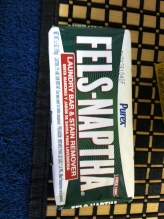 Making your own laundry soap is a chore, it takes discipline, and some patience. For me, it is about frugality, getting back to basics and/or preparing for an emergency. But, it’s not for everyone. I can attest to the fact that it definitely saves money, sometimes just costing pennies a load! Before you get started, here are a few basic tips:
Making your own laundry soap is a chore, it takes discipline, and some patience. For me, it is about frugality, getting back to basics and/or preparing for an emergency. But, it’s not for everyone. I can attest to the fact that it definitely saves money, sometimes just costing pennies a load! Before you get started, here are a few basic tips: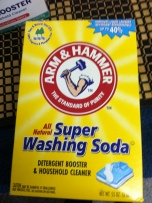 as often)
as often)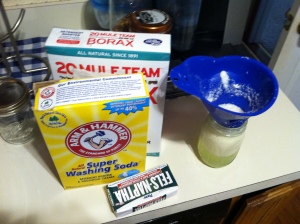
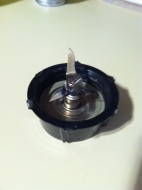 ted liquid and the gel.
ted liquid and the gel.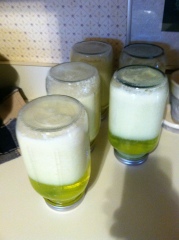 our regular mouthed mason jar containing all of your ingredients.
our regular mouthed mason jar containing all of your ingredients.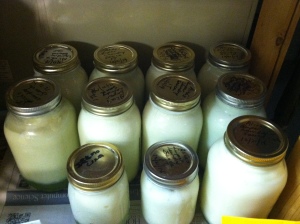
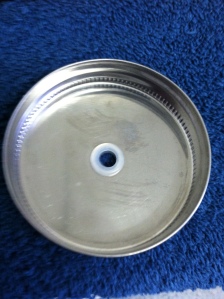 I did not like scooping the thick goopy soap with the tablespoon, holding it ever so carefully while trying to bend over and get it into my front loading he machine without spilling any nor getting my hands all soapy. Just seemed it would get all over stuff over time. Messy. Capricorns don’t like messes and clutter. Efficiency is the name of the game here. Hmmm….think shampoo or hair conditioner squirt bottles?
I did not like scooping the thick goopy soap with the tablespoon, holding it ever so carefully while trying to bend over and get it into my front loading he machine without spilling any nor getting my hands all soapy. Just seemed it would get all over stuff over time. Messy. Capricorns don’t like messes and clutter. Efficiency is the name of the game here. Hmmm….think shampoo or hair conditioner squirt bottles?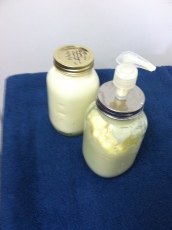 Done.
Done.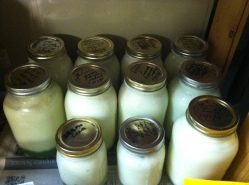 Where Can One Buy the Fels Naptha?
Where Can One Buy the Fels Naptha?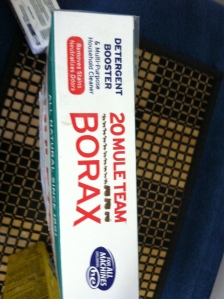
 This is a long read. But, for those genuinely interested, I hope you will appreciate the effort to preserve the history and use of Heirloom corn. Today, there are 142 different types of genetically modified corn, the most of any plant species.
This is a long read. But, for those genuinely interested, I hope you will appreciate the effort to preserve the history and use of Heirloom corn. Today, there are 142 different types of genetically modified corn, the most of any plant species. 
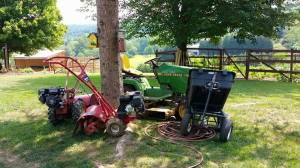
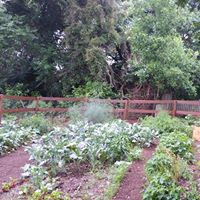 ipate in a local farmers market and I was accepted! This means all the seeds I have been growing, drying and storing will be available. It’s all hand done and very time intensive. I am not a seed company, but sure would like to make a positive impact on other people’s lives with NGMO/Heirloom seeds.
ipate in a local farmers market and I was accepted! This means all the seeds I have been growing, drying and storing will be available. It’s all hand done and very time intensive. I am not a seed company, but sure would like to make a positive impact on other people’s lives with NGMO/Heirloom seeds.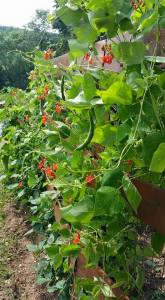 This year’s experiment has been the Baby Hubbard Squash. It has a great history and story. It seems it may have first arrived in Marblehead, MA in the 1700’s aboard sailing ships from the West Indies.
This year’s experiment has been the Baby Hubbard Squash. It has a great history and story. It seems it may have first arrived in Marblehead, MA in the 1700’s aboard sailing ships from the West Indies.







 © Comstock Garden Seeds. Comstock Garden Seeds has specialized in heirloom seeds for 200 years now. You can request a
© Comstock Garden Seeds. Comstock Garden Seeds has specialized in heirloom seeds for 200 years now. You can request a  © The Cook’s Garden. The Cook’s Garden sells vegetable seeds and plants, herb seeds and plants, cottage flowers, and supplies. You’ll find all of these items packed into the free plant and seed catalog that they offer. If you’re in the U.S. or Canada you can fill out the form to request a free The Cook’s Garden plant and seed catalog.
© The Cook’s Garden. The Cook’s Garden sells vegetable seeds and plants, herb seeds and plants, cottage flowers, and supplies. You’ll find all of these items packed into the free plant and seed catalog that they offer. If you’re in the U.S. or Canada you can fill out the form to request a free The Cook’s Garden plant and seed catalog.
 Photo © Dutch Gardens. Dutch Gardens has a free flower catalog available that includes their bulbs, flowers, and fruit plants.You can
Photo © Dutch Gardens. Dutch Gardens has a free flower catalog available that includes their bulbs, flowers, and fruit plants.You can  Photo © Gardens Alive! Gardens Alive! offers a free seed catalog that you can request. Gardens Alive! sells environmentally responsible products for your lawn, soil, and plants to help you control pests and weeds.Those in the continental U.S. can
Photo © Gardens Alive! Gardens Alive! offers a free seed catalog that you can request. Gardens Alive! sells environmentally responsible products for your lawn, soil, and plants to help you control pests and weeds.Those in the continental U.S. can 



 Photo © High Mowing Organic Seeds. You’ll want a High Mowing Organic Seeds catalog if you’re looking for certified organic vegetable, herb, flower, and cover crop seeds. They also have a large selection of heirloom seeds. You can
Photo © High Mowing Organic Seeds. You’ll want a High Mowing Organic Seeds catalog if you’re looking for certified organic vegetable, herb, flower, and cover crop seeds. They also have a large selection of heirloom seeds. You can 
 © HPS Seeds. HPS Seeds sells flowers, vegetables, and herb seeds as well as vines and flower plugs. You can request a
© HPS Seeds. HPS Seeds sells flowers, vegetables, and herb seeds as well as vines and flower plugs. You can request a  © Hydro-Gardens. The Hydro-Gardens free seed catalog has everything you need to help you hydroponic garden grow. For more information, request a
© Hydro-Gardens. The Hydro-Gardens free seed catalog has everything you need to help you hydroponic garden grow. For more information, request a 










































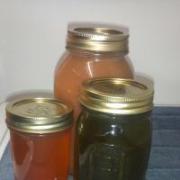 Yesterday I made homemade apple sauce, spiced apple jelly and apple mint jelly. I then canned them all. I ended up with about 8 quarts of apple sauce and 12 pints of apple jelly from a half bushel of apples. I used all the cores and skins to make the jelly and ran out and picked fresh mint from my little herb garden to make apple mint jelly.
Yesterday I made homemade apple sauce, spiced apple jelly and apple mint jelly. I then canned them all. I ended up with about 8 quarts of apple sauce and 12 pints of apple jelly from a half bushel of apples. I used all the cores and skins to make the jelly and ran out and picked fresh mint from my little herb garden to make apple mint jelly.